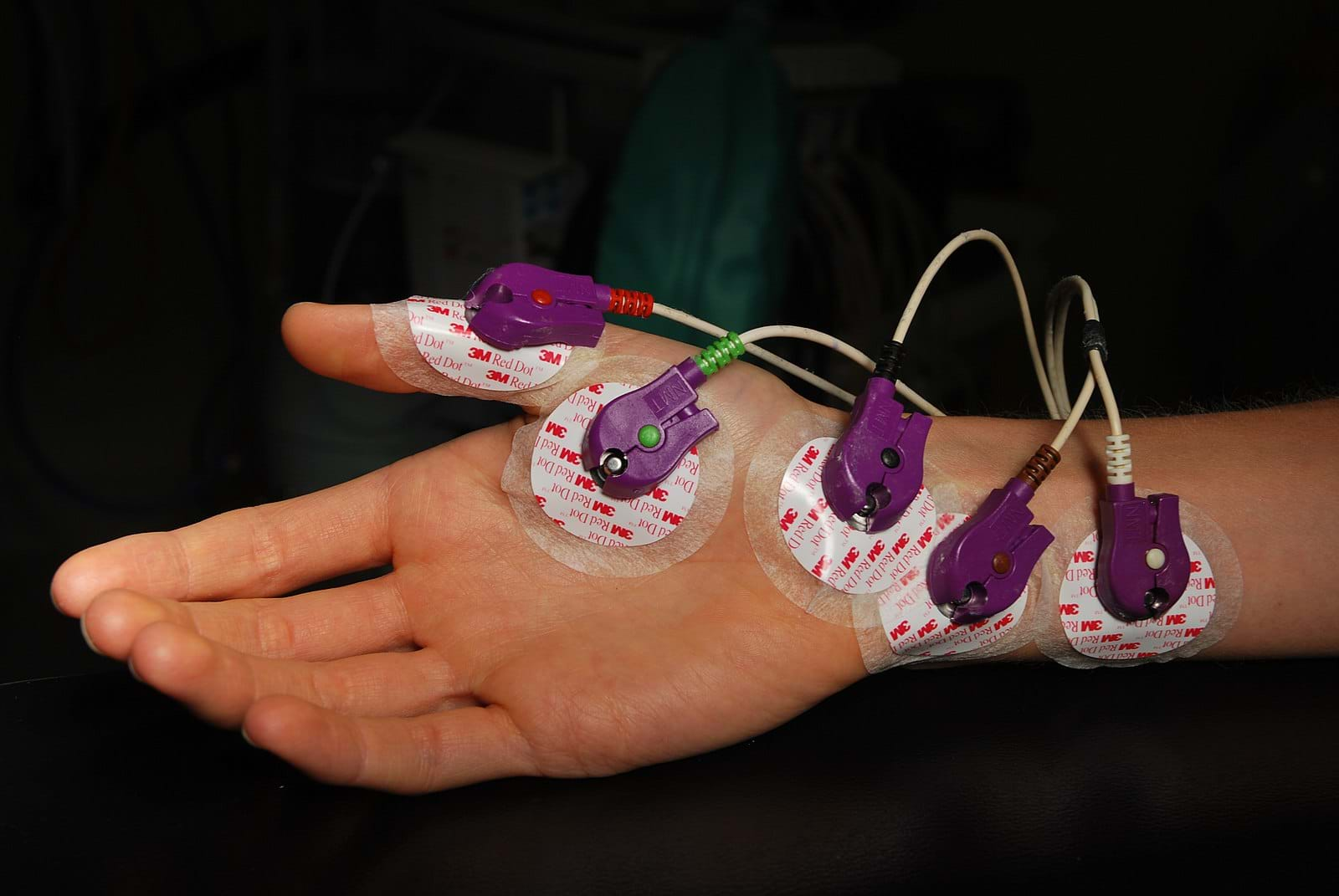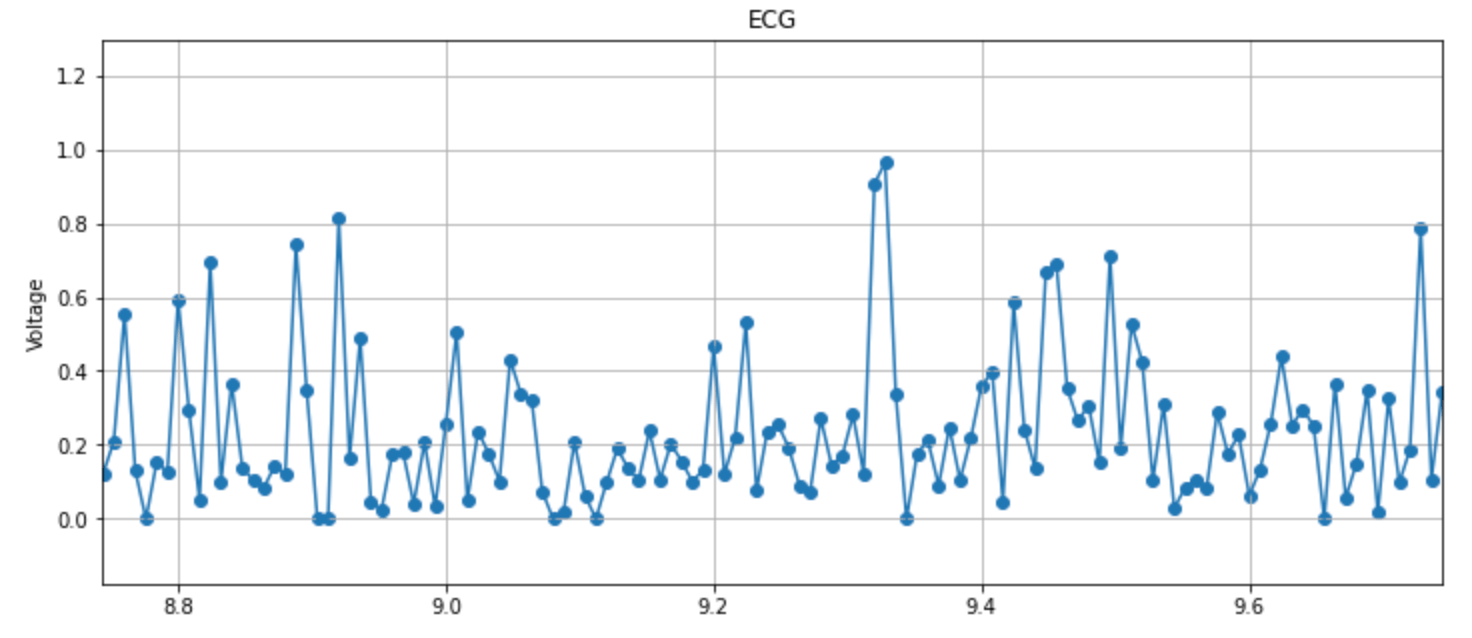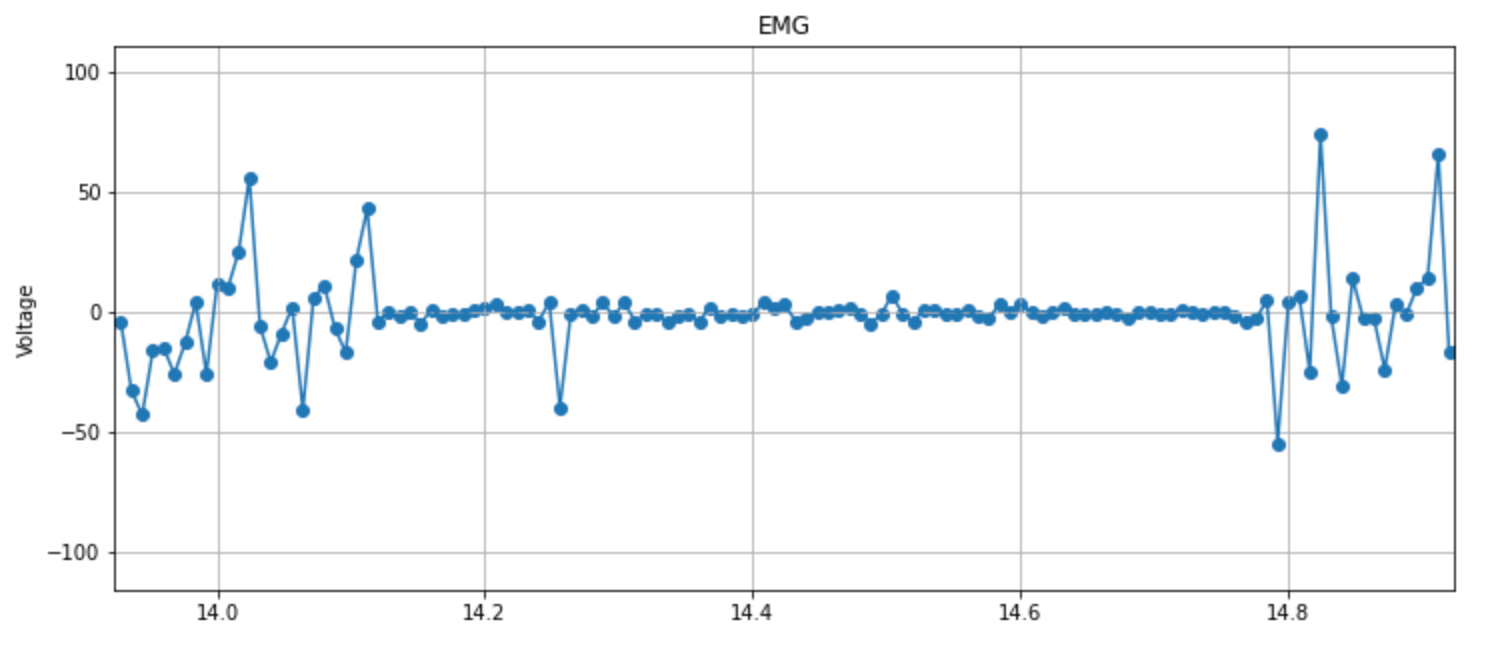Quick Look
Grade Level: 9 (8-10)
Time Required: 2 hours 30 minutes
(three 50-minute class periods)
Expendable Cost/Group: US $0.00
Group Size: 3
Activity Dependency: None
Subject Areas: Data Analysis and Probability, Life Science, Science and Technology

Summary
Students learn about electrocardiography (ECG) and electromyography (EMG) and apply this knowledge to an engineering design activity. First, they briefly compare the heart to a common electronic device, such as a computer or smartphone, to understand how the heart uses electricity to pump blood through the body just as computers and smartphones use electricity to open apps, update the screen, etc. Students then use a Jupyter Notebook, an interactive tool containing pre-written Python code, to analyze and plot real EMG and ECG data. They are asked to adjust plots, make observations, and sketch snippets of the data they viewed. Students also learn about how ECG and EMG measurement capabilities have been integrated into wearables such as smart watches so that users can track their own heart and muscle health daily. In the associated activity, students draw inspiration from smart devices and use the engineering design process to design their own wearable device to track the heart or muscle health of a patient.Engineering Connection
Analyzing data and connecting the math and science concepts from this analysis to a real-world design problem is critical to engineering. This lesson introduces students to electrocardiogram (ECG) and electromyography (EMG) data and applies it to problems of identifying and monitoring various heart and neuromuscular disorders. Students are introduced to engineering and design firsthand when they complete the design activity where they use the engineering design process to propose a design for their own ECG or EMG device for identifying or monitoring a disorder/disease of their choice. Designing a device like this is often the job of biomedical engineers.
Learning Objectives
After this activity, students should be able to:
- Analyze EMG data using pre-written Python code.
- Analyze ECG data using pre-written Python code.
- List and explain important uses for the ECG and EMG in healthcare.
- Discuss how and why tracking patients’ ECG and EMG waves is beneficial in healthcare.
- List some heart and neuromuscular disorders/diseases that may be diagnosed with the help of ECG or EMG analysis.
- Apply the engineering design process and what they know about ECG and EMG to propose a portable healthcare device that uses neural wave analysis.
Educational Standards
Each TeachEngineering lesson or activity is correlated to one or more K-12 science,
technology, engineering or math (STEM) educational standards.
All 100,000+ K-12 STEM standards covered in TeachEngineering are collected, maintained and packaged by the Achievement Standards Network (ASN),
a project of D2L (www.achievementstandards.org).
In the ASN, standards are hierarchically structured: first by source; e.g., by state; within source by type; e.g., science or mathematics;
within type by subtype, then by grade, etc.
Each TeachEngineering lesson or activity is correlated to one or more K-12 science, technology, engineering or math (STEM) educational standards.
All 100,000+ K-12 STEM standards covered in TeachEngineering are collected, maintained and packaged by the Achievement Standards Network (ASN), a project of D2L (www.achievementstandards.org).
In the ASN, standards are hierarchically structured: first by source; e.g., by state; within source by type; e.g., science or mathematics; within type by subtype, then by grade, etc.
NGSS: Next Generation Science Standards - Science
-
CCC.8.9-12.15.
Engineers continuously modify these technological systems by applying scientific knowledge and engineering design practices to increase benefits while decreasing costs and risks.
(Grades 9 - 12)
More Details
Do you agree with this alignment?
-
SEP.1.6-8.1.
Analyze and interpret data to determine similarities and differences in findings.
(Grades 6 - 8)
More Details
Do you agree with this alignment?
-
SEP.1.6-8.3.
Analyze and interpret data to provide evidence for phenomena.
(Grades 6 - 8)
More Details
Do you agree with this alignment?
-
SEP.1.9-12.3.
Analyze data using computational models in order to make valid and reliable scientific claims.
(Grades 9 - 12)
More Details
Do you agree with this alignment?
Materials List
Each group needs:
- laptop/tablet per group member
- Google account per group member
- All three activity worksheets per group member (1 per day): What is an ECG? Jupyter Notebook Activity, What is an EMG? Jupyter Notebook Activity, and Applications of ECG and EMG Design Activity
Worksheets and Attachments
Visit [www.teachengineering.org/activities/view/umo-2558-exploration-ecg-emg-technologies-activity?fbclid=IwZXh0bgNhZW0CMTEAAR7AdCzFvCjTSDVCPbAD-m5ExEoOkcvrmwZIv2e0ehUAarExH6coFG_9PpssyA_aem_zHiUk3meJPUZ-P48czGDoA] to print or download.Pre-Req Knowledge
A familiarity with basic wave analysis (i.e., understand frequency, amplitude, and period of a wave).
Introduction/Motivation
Have you ever wondered how your heart works and how you are able to move your muscles? How is your heart able to never stop pumping blood through your body? What about how your arms and legs move? The heart and nervous systems run on electricity, like how your computer and your smart phone do. The electrical activity of the heart can be measured and monitored by creating an electrocardiogram (ECG), which contains data on the heart’s voltage. Similarly, the electrical activity in the nervous system can be measured using electromyography (EMG). ECG and EMG data can be examined by doctors and researchers to determine if the patient has an abnormality or disease.
In this activity, you will learn how to analyze both ECG waves and EMGs. You will use Python code and Jupyter notebook to analyze EMG and ECG data. Then you will learn how this EMG and ECG data are used in healthcare and some specific disorders/diseases they are used to diagnose and monitor. Then, we will complete a design activity that will walk us through the engineering design process and lead us through creating our own designs of wearable devices that use ECG or EMG to diagnose or monitor potential disease.
Procedure
Background
Electrocardiogram (ECG) data is characterized by an easily recognizable waveform: a larger peak, called the QRS complex, which is preceded and followed by two smaller peaks called the P and T waves, respectfully. Real, raw ECG data may not show these waveforms perfectly, but the QRS complex (or large peak) should be recognizable.

Electromyogram (EMG) data is characterized by spikes that correspond to the subject muscle’s movements and level of movement. Larger, more frequent spikes suggest that the muscle is being used for strong activity, such as lifting a heavy weight. Small, less frequent spikes suggest that the muscle is being used for lighter activity, such as bending the elbow.
Before the Activity
- Review the Jupyter Notebook Guide and complete the tutorials referenced in the guide.
- Make copies of the activity sheets What is an ECG? Jupyter Notebook Activity, What is an EMG? Jupyter Notebook Activity, and Applications of ECG and EMG Design Activity.
- Review the engineering design process with students.
With the Students
Day 1
- Divide class into groups of 2 – 4 students, although students may work on this activity individually.
- Present the What is an ECG? Presentation to introduce students to heart functions and ECG waveforms.
- Hand out a copy of the activity sheet, What is an ECG? Jupyter Notebook Activity, to each student. Each student should turn in their own copy, even if they are in groups. Ensure that students have access to the csv files: ECG_Example1 and ECG_Example2.
- Demonstrate how to open and run a Jupyter Notebook as shown in the Jupyter Notebook Guide.
- Encourage students in groups to help each other if they get stuck. If students are working individually, they may ask their neighbors for help.
Day 2
- Separate the class into the same groups as Day 1.
- Present the What is an EMG? Presentation to introduce students to EMG waveforms and motor neurons.
- Hand out a copy of the activity sheet, What is an EMG? Jupyter Notebook Activity, to each student. Each student should turn in their own copy, even if they are in groups. Ensure that students have access to the csv files: EMG_Example1 and EMG_Example2.
- Encourage students in groups to help each other if they get stuck. If students are working individually, they may ask their neighbors for help.
Day 3
- Hand out a copy of the Applications of ECG and EMG Design Activity to each group. Each group should turn one design.
- Present the Applications of ECG and EMG Presentation to explore how doctors use ECG and EMG data to detect and mitigate health problems.
- Students may use Google (or another search engine) for inspiration and ideas, but they may NOT copy an existing idea (for example, students cannot design a smart watch).
- Encourage each student to research independently and then share with the group, each group will then design one wearable device.
Vocabulary/Definitions
electrocardiogram (ECG): A graph of voltage versus time of the electrical activity of the heart using electrodes placed on the skin.
electromyography (EMG): A technique for evaluating and recording the activation signal of muscles.
heart: A muscular organ that pumps blood through the body, traditionally thought to be the seat of emotion.
heart arrhythmia: An irregular heartbeat.
muscle: A contractile form of tissue which animals use to effect movement.
muscular dystrophy: A group of genetic diseases which cause progressive skeletal muscle weakness, defects in muscle proteins, and the death of muscle cells and tissue.
Assessment
Pre-Activity Assessment
Day 1:
Pre-Quiz: Conduct the What is an ECG? Activity Pre-Quiz.
Day 2:
Pre-Quiz: Conduct the What is an EMG? Activity Pre-Quiz.
Day 3:
Pre-Quiz: Conduct the Applications of ECG and EMG Activity Pre-Quiz.
Activity Embedded (Formative) Assessment
Day 1:
ECG Activity: Students complete the What is an ECG? Jupyter Notebook Activity.
Day 2:
EMG Activity: Students complete the What is an EMG? Jupyter Notebook Activity.
Day 3:
Applications of ECG and EMG: Students complete the Applications of ECG and EMG Design Activity.
Post-Activity (Summative) Assessment
Day 1:
Post-Quiz: Conduct the What is an ECG? Activity Post-Quiz.
Day 2:
Post-Quiz: Conduct the What is an EMG? Activity Post-Quiz.
Day 3:
Post-Quiz: Conduct the Applications of ECG and EMG Activity Post-Quiz.
Investigating Questions
- Can you define an EMG and ECG? (Answer: EMG stands for electromyography, which is an electrodiagnostic technique for evaluating and recording the electrical activity produced by skeletal muscles. ECG (electrocardiogram) is a test used to measure the electrical activity of the heart.)
- How can scientists use these to uncover medical conditions? (Answer: Scientists can use ECG data to measure the rhythm and orientation of the heart to detect signals of malfunction or disease. EMG can show if muscle weakness is due to problems within the muscle or if there is an underlying nerve condition.)
- Step into the shoes of a biomedical engineer – how might a wearable device which monitors electricity through the body be useful to doctors? (Student answers may vary. Examples: To get a baseline value from a person wearing it daily. To evaluate the health of athletes’ muscles during training.)
Activity Extensions
After students complete their designs, have some students volunteer to share their designs. Have the volunteers take turns sharing their sketches and their design considerations (where is their device worn on the body, what disorder/disease is it diagnosing/monitoring, etc.)
Additional Multimedia Support
Optional: TeachEngineering has a great unit on Creative Engineering Design that could extend on students’ exposure to the engineering design process in this activity.
Subscribe
Get the inside scoop on all things TeachEngineering such as new site features, curriculum updates, video releases, and more by signing up for our newsletter!More Curriculum Like This

In this second activity, students dive deeper into the neuromuscular system by exploring how the body recruits and activates muscles in response to various gestures. They begin by examining the neuromuscular junction and diagramming the neuronal circuitry pathway involved in muscle activation. Using...

Students learn how the heart functions. They are introduced to the concept of action potential generation, which causes the electrical current that triggers muscle contraction in the heart.

Students learn basic coding in Python, a high-level language that is known for its ease of use and various applications. They learn about the basic programming structures such as variables, objects, classes, and instances, and programming concepts such as if-else statements, loops, and functions.

Students use Arduino microcontrollers to measure heart rate and blood oxygen levels with the MAX30102 sensor board and to capture electrocardiogram (ECG) signals using the AD8232 sensor board. They analyze the data to detect arrhythmias by comparing results from both sensors. Throughout the activity...
Other Related Information
Students should have individual access to Google (or other search engine) for researching information for the design activity. Students should also have access to Google Colab and Jupyter Notebook (Available online through Google Drive).
Copyright
© 2023 by Regents of the University of Colorado; original © 2019 University of MissouriContributors
Erin Shappell; Dr. Satish Nair; Keegan Welch; Isabel Banks; Nathan Opsal; Adam MenkerSupporting Program
Research Experiences for Teachers in Neural Engineering, University of MissouriAcknowledgements
This work is based upon work supported in part by the National Science Foundation under grant no. EEC-1801666—Research Experiences for Teachers in Neural Engineering at the University of Missouri. Any opinions, findings and conclusions or recommendations expressed in this material are those of the authors and do not necessarily reflect the views of the National Science Foundation.
Last modified: March 20, 2023









User Comments & Tips